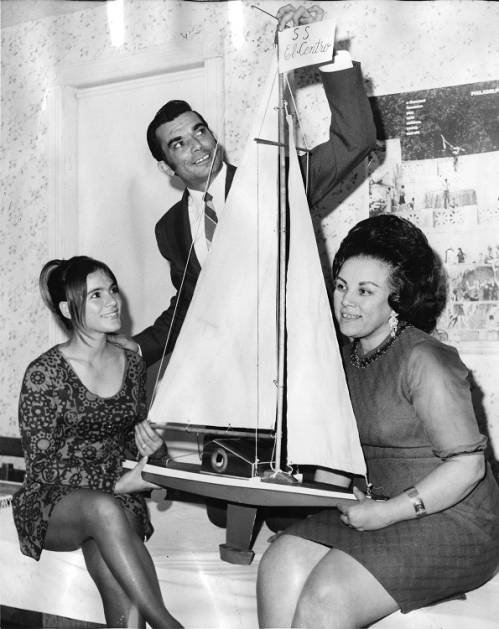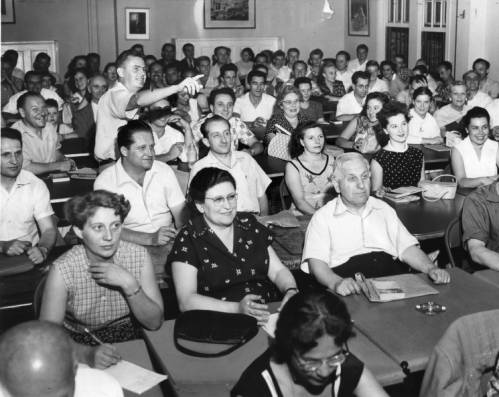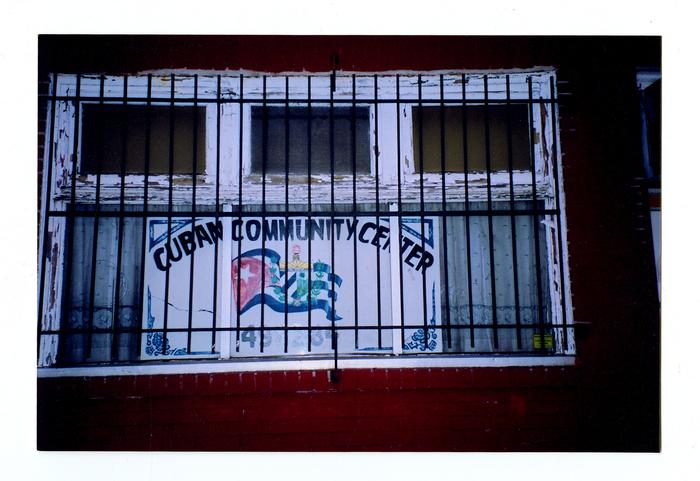Nationalities Service Center
Essay
The Philadelphia branch of the International Institute, renamed the Philadelphia Nationalities Service Center in 1963, opened in June 1922 and initially operated under the auspices of its sponsor, the Young Women’s Christian Association (YWCA). Like the four to five dozen other International Institute branches in operation by the 1920s, the Philadelphia effort aided immigrant women in learning English, developing employment skills, and navigating the naturalization process. In the 1930s, the group incorporated independently of the YWCA and expanded its focus to include men and families. After World War II, the organization increasingly turned its attention to fostering and moderating community discussion about race and culture and helping to resettle thousands of refugees to the greater Philadelphia area.
Often compared with settlement houses, which shared similar aims and originated at similar times, the International Institutes were founded in 1910 in New York City by social worker Edith Terry Bremer (1885-1964). Historian Kristin Hoganson has argued that the Institutes represented a part of the “immigrant gifts” movement in which, like settlement houses, non-immigrant whites appropriated the folk traditions of immigrants to celebrate a vision of pluralism and acculturation. Institute branches sponsored folk festivals, internationality dinners, and other programming that celebrated immigrant folk traditions (and, to some degree, the modern scientific and cultural innovations that immigrants contributed to the United States).
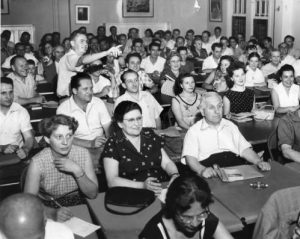
While the Institute began as a social organization for immigrant women, it soon offered courses in English and, with the advent of restrictive immigration quotas under the National Origins Act of 1924, began casework assisting young immigrant women in understanding and completing the naturalization process. Such efforts were not without the paternalist assumptions of almost all Progressive Era, white-organized immigration services. But unlike settlement houses, in which white middle class “settlers” lived among immigrants and promoted middle class beliefs about domesticity, most served by the organization lived outside the Institute headquarters, which employed first or second-generation caseworkers fluent in immigrant languages. By 1929, the Institute had caseworkers who spoke Russian, Czech, Armenian, Italian, Polish, and German; by 1933, staff and volunteer interpreters spoke over a dozen languages, including Hindi, Armenian, Portuguese, Polish, Arabic, and Greek.
Facing fragmented social service and immigration systems, which rarely offered new Americans the same opportunities as those born in the United States, immigrants came to the International Institute to develop employment, social, and naturalization strategies. Institute caseworkers also could often help with matters such as proving that immigrants had arrived in the country prior to the quota system, identifying documents necessary for naturalization, answering questions about immigration status related to a marriage or divorce, or helping immigrants extend their stay. For example, the Institute helped a young man born in Turkey achieve permanent residency after he faced deportation because his father’s marriage, and therefore his own citizenship, had been declared illegal. The Institute helped a Chinese immigrant family secure passage for a child who had been left behind due to pneumonia. As early as the 1950s, the Institute offered interpreter services for community groups interacting with English-language learners. In performing its work, the Institute frequently collaborated with Jewish, Catholic, Quaker, and Protestant social service agencies in the city, but it claimed to be the first nonsectarian organization of its type to serve Philadelphia.
During the Second World War, the U.S. government commissioned the Philadelphia Institute to help immigrants comply with the Smith Act (Alien Registration Act) of 1940 by providing loans for citizenship applications, interpreting the requirements of the act, and serving as a liaison with naturalization services. When Pennsylvania prevented immigrants who had not declared their intentions to naturalize from obtaining welfare, the Institute offered funds for immigrants to initiate the naturalization process. Similarly, naturalized immigrants needing documentation to work for defense contractors frequently came to the organization to help.
Before and after the war, immigrants (and non-immigrants) also used the organization to build community within and across ethnic groups, and second-generation youngsters came to the Institute to socialize with children outside their own ethnic groups and to reconnect with their heritage. Immigrants took classes in English, Spanish, and other languages. Affiliated organizations of immigrants and non-immigrants—like the Polish KOP Club, the Japanese-American Citizens’ League, the Women’s International Council, or the American Indian Society—held events in the organization’s space. From the 1920s through the 1950s, an annual Internationality Dinner celebrated different national foods, and Sunday Teas and Starlight Balls in the 1950s and 1960s offered opportunities for immigrants of different national origins to socialize. Between 1956 and 1984, the organization sponsored a folk festival, which at its peak attracted tens of thousands of visitors over three days and represented more than five dozen nationalities.
Refugee Resettlement Efforts
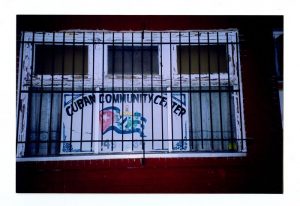
Under the federal Displaced Persons Act of 1948 and the Refugee Relief Act of 1953, the organization became increasingly involved in refugee and displaced person resettlement. Its most high-profile effort involved refugees fleeing the fallout from the Hungarian and Cuban revolutions, and in the 1970s the NSC helped thousands of refugees from Southeast Asia resettle in Philadelphia. The group’s role in resettling refugees varied. In the late 1940s and early 1950s, caseworkers primarily helped displaced persons from Europe find employment. During the resettlement of about 100 Cuban families in the early 1960s, it communicated with the International Rescue Committee (IRC) in Miami to select families, plan their well-publicized “Freedom Flights” to Philadelphia, and identify southeastern Pennsylvania families to sponsor them (usually through religious groups). The Institute helped identify possible jobs for the groups or connect them with employment agencies, provide temporary housing, connect with Cubans living in Philadelphia already, disburse funding from the IRC, access furniture and clothing from public assistance programs, arrange for English classes, and coordinate with other resettlement groups.
Resettlement efforts were rarely without complications, and new Philadelphians who resettled with the NSC’s help repeatedly advocated for improved access to adequate resources for making a new life in their new city. Refugees who had been highly skilled workers and professionals raised concerns that they were overqualified for the unrewarding jobs found for them—often clerical or custodial. At one point, a group of nine recently-resettled Cuban families wrote to the NSC requesting better treatment and considered reporting inadequate conditions to the newspapers. Refugee communities proved resilient, entrepreneurial, and resourceful: a 33- year-old Cambodian man named Hort helped Cambodian arrivals who resettled with the assistance of the NSC to secure better lodging and fix heat and gas utilities that would not turn on. With his own money, he purchased a van to take community members to English lessons, teach them to drive, purchase groceries, and wash clothes at the laundry.
The Institute’s name change to Nationalities Service Center in 1963 reflected a desire to differentiate itself from the International House, with which it was often confused, and signaled a broadening of the organization’s scope during the 1960s and 1970s to include services and engagement for non-immigrants. (The Institutes’ umbrella organization also changed its name, from the Institute for Immigrant Welfare to the American Council of Nationalities Service.) Beginning in the second half of the 1960s—pushed by the accomplishments of freedom and civil rights movements and a growing understanding of the intertwined dynamics of immigrant life and racial justice—the organization attempted to influence broader conversations about race, ethnicity, and cultural understanding. During the 1960s and 1970s, the Center sponsored conferences on subjects like bilingual education and affirmative action and held cultural workshops and training. It secured a grant in 1968 to fund the “Nationality Race Community Relations” project. Partly driven by concern about rising racism among ethnic whites in Philadelphia, the project produced a World Cultures curriculum taken by 63 Black and white students from William Penn High School and John Hallahan Catholic Girls School. The project director, Jaipaul, and school officials later testified at Congressional hearings that led to the passage of the 1974 Ethnic Heritage Study Center Act.
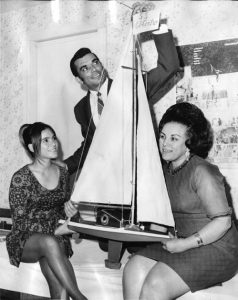
Some projects were brief and troubled. Starting in the mid-1960s, the Center expanded its outreach to Puerto Rican Philadelphians, culminating in 1971 with the creation of “El Centro,” a Spanish-language satellite center in North Philadelphia intended to build connections with Spanish-speaking Philadelphians, organize child care services, and serve as a bilingual community space. The program was short-lived, however. Puerto Rican community leaders in Philadelphia asked that services for their community be designed and administered by Puerto Ricans, and some asked that El Centro serve more as a neighborhood center rather than an extension of Nationality Service Center services.
Shifting immigration patterns during the 1960s also meant a shifting range of services for immigrant Philadelphians. Assisting relatives in coming to the United States became increasingly important as chain migration and numbers of highly skilled immigrants grew. In the mid-1970s, the NSC continued its important role in resettlement by aiding thousands of Vietnamese, Cambodian, Laotian, and Hmong refugees. Because federal resources for resettlement were inadequate, these refugees often found themselves in substandard housing or without an infrastructure for finding sustainable work. In addition to helping to secure housing and offering classes in English language and practical skills, the NSC in this period employed bilingual mental health workers to provide counseling for refugees, chaired a Refugee Task Force, and partnered with other organizations to coordinate medical care.
After 1980, the NSC continued to grow and worked in coalitions to advocate for immigration reform and continued refugee resettlement, helping political refugees resettle from Albania, Kosovo, the Congo, Eritrea, Bhutan, Nepal, Iraq, Syria, and elsewhere. The organization’s services expanded in the late twentieth and early twenty-first centuries to reflect the complexities of resettlement, including refugee healthcare, legal services for unaccompanied minors, initiatives opposing human trafficking, and legal advocacy. As anti-immigrant politics of the 2010s restricted the number of refugees for resettlement, the Nationalities Service Center faced new challenges, including hiring freezes and staff layoffs. But as the city’s first nonsectarian organization dedicated to assisting in the naturalization process, the Nationalities Service Center had a record of welcoming thousands of new Americans as they sought to make their homes in Philadelphia.
Andrew McNally received his Ph.D. from the University of Minnesota in 2017. His dissertation explored the history of the international understanding movement in U.S. education. (Author information current at time of publication.)
Copyright 2019, Rutgers University
